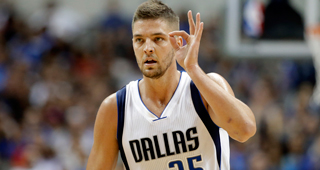It feels like a lifetime ago, but at one point in the shockingly recent past, Chandler Parsons was better known as the personification of Daryl Morey’s shrewd approach to team-building than a promising NBA player.
In just his second season, Parsons caught Kobe Bryant’s eye, and was an efficient, evolving talent, locked into the most valuable (non-max) contract in the league. Morey signed him to a four-year, $3.7 million deal. The first two seasons were guaranteed, but the final two were not.
Despite averaging 15.5 points, 5.3 rebounds and 3.5 assists per game as an NBA sophomore, Parsons’ contract was normally reserved for someone producing a third of his nightly output. He was a $10 cashmere sweater made from real cashmere.
Again, this seems so distant from present day, but only three years ago, Parsons was James Harden’s sidekick on one of the league’s most exuberant and lovable teams. He played an unquantifiable yet critical role helping convince Dwight Howard of Houston’s desirability. His hair was shaggy. So much has happened since.
In search of fair compensation, Parsons signed an offer sheet with the Dallas Mavericks in 2014. Morey later called it “one of the most untradable structures” ever. On the court, Parsons was improving by the day, but his spreadsheet shine had evaporated.
The transition to Dallas hasn’t been all fun and games, though. Early on, Parsons struggled to embed himself in a new ball-hopping offensive system, feuded with Rick Carlisle, had major knee surgery and was legendarily cold-shouldered by DeAndre Jordan.
But all of it has led to now. This is a contract year for Parsons, the same summer the NBA’s salary cap is projected to spike from $70 million to $89-92 million. And life could not be any better.
Before Sunday night’s rough overtime loss against the Denver Nuggets, the 27-year-old’s post-All-Star weekend numbers were tremendous. He’s averaging 20.9 points, 4.9 rebounds and 3.6 assists per game. That isn’t the largest sample size, though. More substantial than that, however, is the 30-plus-game stretch since he re-entered Dallas’ starting lineup on a full-time basis.
Since then, Parsons is launching 4.7 threes per game, and nailing a ridiculous 46.2 percent of them. How good is that? Of all players firing up at least four three-point attempts per game since December 28th, only J.J. Redick and Steph Curry are more accurate, per NBA.com.
Dallas is outscored by 5.6 points per 100 possessions over that span when Parsons isn’t on the floor—the largest deficit on the team—and its offense trips up as much as it does when Dirk Nowitzki doesn’t play.
Speaking of Dirk, Parsons’ FG% is 4.7% higher when he’s on the floor by himself. The percentage of Parsons’ points that come from fastbreak opportunities nearly doubles and he’s 9.5% more accurate in the restricted area. He’s the Mavericks’ best player right now, in a contract year, when well over half the league will be more than happy to throw a max deal in his direction this summer.
For teams that strike out on Kevin Durant, Parsons isn’t a terrible Plan B. He’s a 6’10” stretch four who can comfortably run a pick-and-roll and thrive as an efficient primary option.
Here’s looking at you, Washington Wizards. Wrap your head around a John Wall, Bradley Beal, Otto Porter, Chandler Parsons, Markieff Morris group serving under a head coach who’s comfortable playing all five at the same time? Beyond that, imagine Parsons taking the league’s most coveted free agents on a tour of the Vietnam Memorial, driving by the Washington Monument and really selling them on a new life in the nation’s capital.
If that doesn’t work out, maybe he’ll be the first free agency domino to fall for the post-Kobe Bryant era Los Angeles Lakers? Or he’ll go home to the Orlando Magic and save his hometown team from total embarrassment after they prioritized cap space over a possible first-round draft pick in the Tobias Harris trade (a Parsons, Aaron Gordon, Al Horford—who went to the same college as Parsons—frontline could be special).
Maybe he joins the sugary Portland Trail Blazers and becomes the left jab to Damian Lillard’s uppercut, or gives the Boston Celtics that scoring presence they really need. Teaming up with Anthony Davis down in New Orleans makes sense—so long as Davis moves to center—if they move on from Ryan Anderson.
And what about a trip back to Houston? What if Morey swallows his pride and is willing to fill one of his maximum contract slots with a player who once symbolized his eye for value? It’s all possible. Anything is, really, including the strong possibility that he stays put in Dallas.



